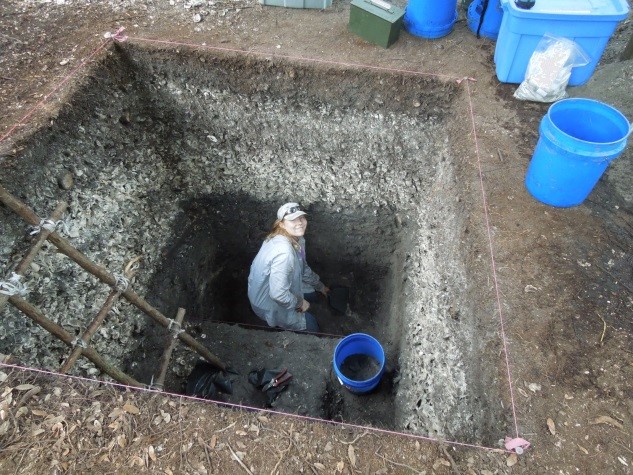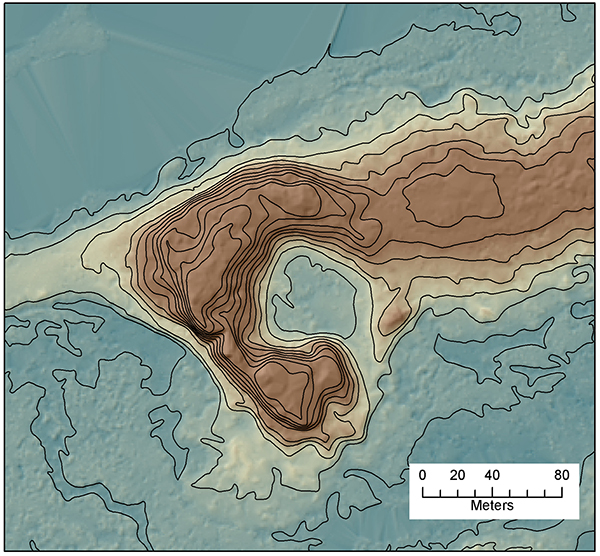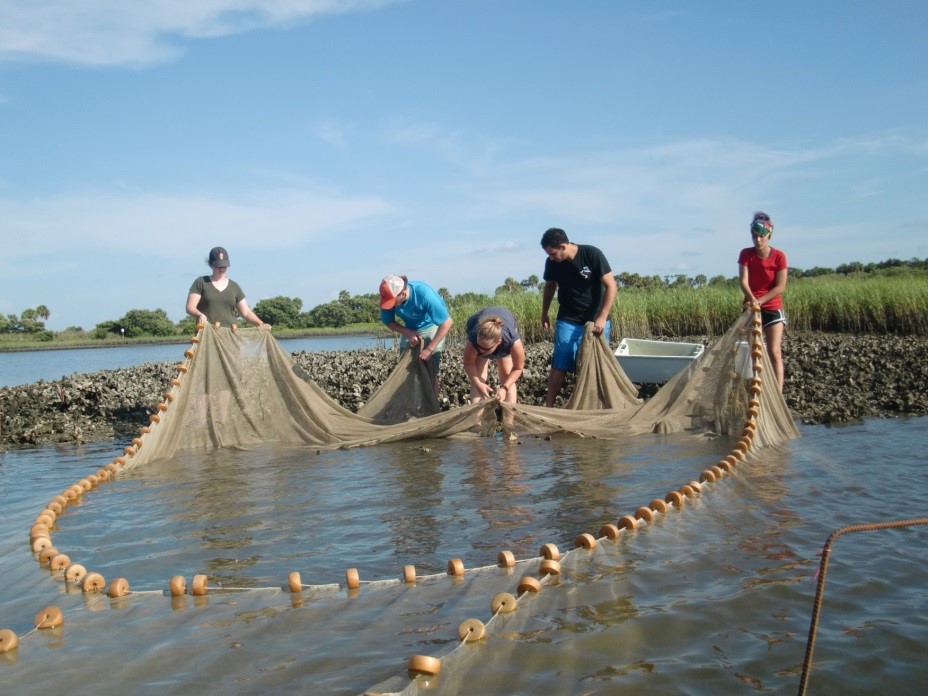 The Lower Suwannee Archaeological Field School is a nine-credit field practicum in all aspects of archaeological field work, including reconnaissance survey, site mapping, stratigraphic testing, and block excavation. Included is a module in experimental archaeology involving mass-capture fishing technologies. Evening laboratory sessions and lectures provide additional training in analysis, research design, and regional archaeology. Students also gain experience in the use of electronic survey equipment and other hi-tech applications in mapping and surveying. The focus of field school in the summer of 2015 is the abundant archaeological record of coastal dwelling in the greater Cedar Key area of the north Gulf Coast of Florida.
The Lower Suwannee Archaeological Field School is a nine-credit field practicum in all aspects of archaeological field work, including reconnaissance survey, site mapping, stratigraphic testing, and block excavation. Included is a module in experimental archaeology involving mass-capture fishing technologies. Evening laboratory sessions and lectures provide additional training in analysis, research design, and regional archaeology. Students also gain experience in the use of electronic survey equipment and other hi-tech applications in mapping and surveying. The focus of field school in the summer of 2015 is the abundant archaeological record of coastal dwelling in the greater Cedar Key area of the north Gulf Coast of Florida.
 The shores of north Gulf Coast have been home to coastal communities for over 12,000 years. When people first arrived in the region at the end of the Ice Age, sea level was 100 m lower than today and the shoreline some 200 km west of its present location. Archaeological traces of the oldest communities were flooded long ago by rising seas, but after about 5,000 years ago the rate of change slowed enough to enable coastal communities to establish relatively permanent use of rich estuarine habitats. Massive ridges of oyster shell (such as Shell Mound, shown to the left), sand mounds, cemeteries, and extensive deposits of everyday living attest to intensive settlement throughout the Cedar Key area. But like those who came before and those who followed after, the communities creating this incredible archaeological record had to confront changes in their world—environmental, social, and cultural—that challenged their permanence. Field school research is designed to document human responses to changes long ago in order to contribute time-depth to the challenges of change going forward.
The shores of north Gulf Coast have been home to coastal communities for over 12,000 years. When people first arrived in the region at the end of the Ice Age, sea level was 100 m lower than today and the shoreline some 200 km west of its present location. Archaeological traces of the oldest communities were flooded long ago by rising seas, but after about 5,000 years ago the rate of change slowed enough to enable coastal communities to establish relatively permanent use of rich estuarine habitats. Massive ridges of oyster shell (such as Shell Mound, shown to the left), sand mounds, cemeteries, and extensive deposits of everyday living attest to intensive settlement throughout the Cedar Key area. But like those who came before and those who followed after, the communities creating this incredible archaeological record had to confront changes in their world—environmental, social, and cultural—that challenged their permanence. Field school research is designed to document human responses to changes long ago in order to contribute time-depth to the challenges of change going forward.
 Field school is a component of the Lower Suwannee Archaeological Survey, a partnership between the University of Florida and U.S. Fish and Wildlife Service to locate and document sites in refuge lands stretching from Cedar Key to Horseshoe Beach. Students will participate in the survey and testing of sites at several locations in the Cedar Key area, including offshore islands. In addition, students will participate in the construction and use of fish weirs to collect data on the relative value of alternative fishing technologies.
Field school is a component of the Lower Suwannee Archaeological Survey, a partnership between the University of Florida and U.S. Fish and Wildlife Service to locate and document sites in refuge lands stretching from Cedar Key to Horseshoe Beach. Students will participate in the survey and testing of sites at several locations in the Cedar Key area, including offshore islands. In addition, students will participate in the construction and use of fish weirs to collect data on the relative value of alternative fishing technologies.
Beyond the fee for nine undergraduate credit hours (ANT 4123/4124), students pay their share of communal subsistence, housing, and equipment costs (estimated at $800). During the field session (July 6 – August 7) students will reside in Cedar Key through the weekdays and return to Gainesville on weekends. One week of lab orientation on the University of Florida campus in Gainesville (June 29 – July 2) is mandatory.
The Lower Suwannee Archaeological Field School is directed by Dr. Kenneth Sassaman, with the assistance of Ph.D. student Ginessa Mahar, whose dissertation project on changing fishing technologies structures much of the program. Other graduate students instruct and supervise field school students on various aspects of the research. Contact Dr. Sassaman (sassaman@ufl.edu) for an application form. Due date for applications is March 20, 2015. Students will be notified about admission decisions by April 10, 2015.
A summary of the 2014 Lower Suwannee Archaeological Field School can be found here.
Reports
Additional reports of the Lower Suwannee Archaeological Survey are available for review below:
- McFadden, Paulette S., and Andrea Palmiotto. 2013. Archaeological Investigations at Ehrbar (8LV282), Levy County, Florida. Technical Report 17.
- Sassaman, Kenneth E., Andrea Palmiotto, Ginessa J. Mahar, Micah P. Mons, and Paulette S. McFadden. 2013. Archaeological Investigations at Shell Mound (8LV42), Levy County, Florida: 2012 Testing. Technical Report 16.
- Mones, Micah P., Neill J. Wallis, and Kenneth E. Sassaman. 2012. Archaeological Investigations at Deer Island, Levy County, Florida. Technical Report 15.
- McFadden, Paulette S., and Andrea Palmiotto. 2012. Archaeological Investigations at Bird Island (8DI52), Dixie County, Florida. Technical Report 14.
- Sassaman, Kenneth E., Paulette S. McFadden, and Micah P. Mones. 2010. Lower Suwannee Archaeological Survey 2009-2010: Investigations at Cat Island (8DI29), Little Bradford Island (8DI32), and Richards Island (8LV137). Technical Report 10.